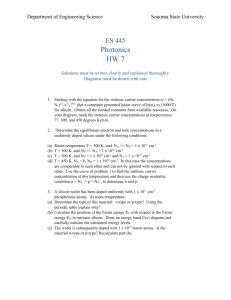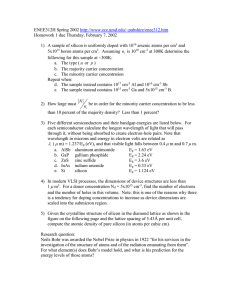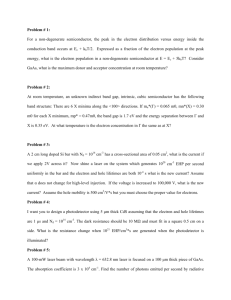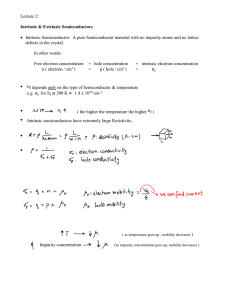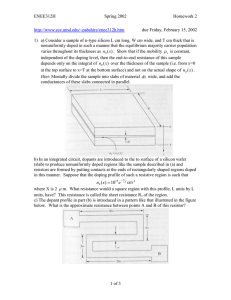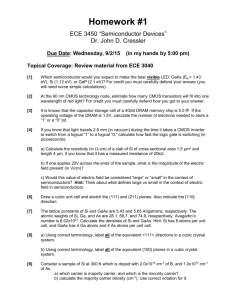Assignment-01
advertisement
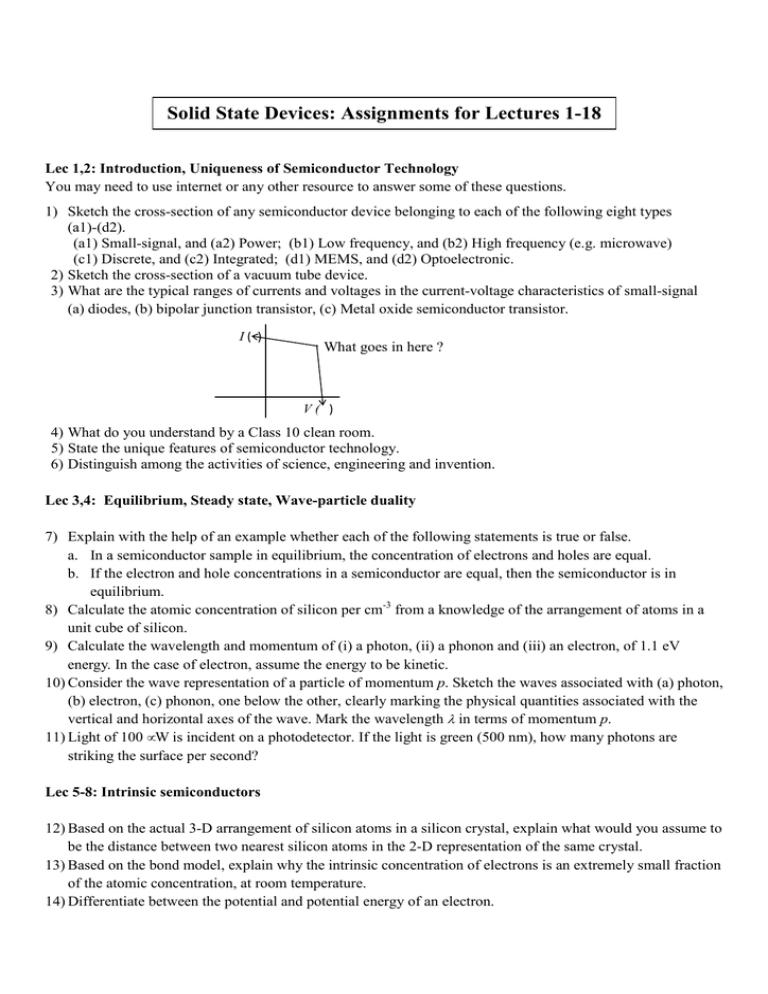
Solid State Devices: Assignments for Lectures 1-18 Lec 1,2: Introduction, Uniqueness of Semiconductor Technology You may need to use internet or any other resource to answer some of these questions. 1) Sketch the cross-section of any semiconductor device belonging to each of the following eight types (a1)-(d2). (a1) Small-signal, and (a2) Power; (b1) Low frequency, and (b2) High frequency (e.g. microwave) (c1) Discrete, and (c2) Integrated; (d1) MEMS, and (d2) Optoelectronic. 2) Sketch the cross-section of a vacuum tube device. 3) What are the typical ranges of currents and voltages in the current-voltage characteristics of small-signal (a) diodes, (b) bipolar junction transistor, (c) Metal oxide semiconductor transistor. I( ) What goes in here ? V( ) 4) What do you understand by a Class 10 clean room. 5) State the unique features of semiconductor technology. 6) Distinguish among the activities of science, engineering and invention. Lec 3,4: Equilibrium, Steady state, Wave-particle duality 7) Explain with the help of an example whether each of the following statements is true or false. a. In a semiconductor sample in equilibrium, the concentration of electrons and holes are equal. b. If the electron and hole concentrations in a semiconductor are equal, then the semiconductor is in equilibrium. 8) Calculate the atomic concentration of silicon per cm-3 from a knowledge of the arrangement of atoms in a unit cube of silicon. 9) Calculate the wavelength and momentum of (i) a photon, (ii) a phonon and (iii) an electron, of 1.1 eV energy. In the case of electron, assume the energy to be kinetic. 10) Consider the wave representation of a particle of momentum p. Sketch the waves associated with (a) photon, (b) electron, (c) phonon, one below the other, clearly marking the physical quantities associated with the vertical and horizontal axes of the wave. Mark the wavelength λ in terms of momentum p. 11) Light of 100 µW is incident on a photodetector. If the light is green (500 nm), how many photons are striking the surface per second? Lec 5-8: Intrinsic semiconductors 12) Based on the actual 3-D arrangement of silicon atoms in a silicon crystal, explain what would you assume to be the distance between two nearest silicon atoms in the 2-D representation of the same crystal. 13) Based on the bond model, explain why the intrinsic concentration of electrons is an extremely small fraction of the atomic concentration, at room temperature. 14) Differentiate between the potential and potential energy of an electron. 15) Why are electron potential energies in a crystal negative ? 16) Explain why the units of density of states function N(ε) is cm-3ev-1 and not just cm-3. 17) A metal has a density of states distribution N(ε) = 6.82 x 1021 ε cm-3eV-1, where ε is in eV and measured from the bottom of the band. The concentration of electrons in a small energy interval between ε1 = 4.6 eV and ε2 = 4.601 eV is 2.07 x 1015 cm-3. Determine the fraction of the states between ε1 and ε2 occupied by electrons and the position of the Fermi-level. 18) Show that the effective density of states at the conduction band edge, Nc, in silicon represents the number of states per unit volume in a strip 1.2kT wide near the conduction band edge. 19) If it is known that, in a certain material, 1 percent of the states at level ε = εf – 0.25 eV are vacant, what is the temperature ? 20) Compute ni of Si and GaAs at 300 K using the values of Nc, Nv and εg given in the class and compare it with the given value of ni. Comment on the values obtained. 21) Find the energy by which εi is offset from the midgap of Si at 300 K. Lec 9-11: Extrinsic semiconductors 22) Explain why it is acceptable to regard 1 cm3 of a semiconductor block as doped “uniformly” with 1010 dopants per mm3, but inappropriate to regard 1 mm3 of the same block as doped “uniformly” with 10 dopants per µm3, though 1010 mm-3 = 10 µm-3. 23) Derive a formula to show that Bohr model predicts the energy of the electron revolving around the nucleus to be inversely proportional to εr2, where εr is the dielectric constant of the medium between the electron and the nucleus. 24) Sketch the following for phosphorus doped silicon in thermal equilibrium. (a) Electron concentration due to impurity ionization as a function of temperature. (b) EHP concentration due to thermal generation or silicon ionization as a function of temperature. Explain the behavior sketched based on the bond model. 25) Reason out qualitatively how, in a semiconductor under equilibrium, the pn product remains constant = ni2 with changes in doping. 26) Consider a Silicon sample doped uniformly with Nd cm-3 phosphorus atoms, under equilibrium and room temperature. Generally, we calculate the carrier concentration in the extrinsic range by assuming a single impurity level, complete impurity ionization, Boltzmann approximation and the band gap to correspond to that of pure silicon. Determine the critical values of Nd beyond which: a. impurity level spreads into a band, i.e. the orbits of the fifth electrons of the phosphorus atoms overlap; b. complete ionization approximation fails, i.e. ionization falls below 95 %; c. Boltzmann approximation to the Fermi-dirac function fails; d. band gap narrowing sets in, i.e. the bandgap falls below 95% of the low doping value (use an empirical formula from some text book, internet or any literature). 27) Consider two silicon samples doped with 1015 cm-3 and 1018 cm-3 phosphorus atoms. Estimate the majority and minority carrier concentrations and the Fermi-level in the samples at three temperatures, namely - 77 K (liquid nitrogen temperature), 300 K (room temperature) and 600 K. For estimating the majority carrier concentration and Fermi-level at any temperature and doping, use the following procedure: (i) assume that impurities are ionized completely, Boltzmann approximation holds and thermal generation is negligible; (ii) check the validity of the assumptions made; (iii) if an assumption is invalid, explain how that assumption can be relaxed and an improved formula used. For each temperature and doping, draw a band diagram showing the values of all energy levels with respect to εc. Tabulate your results in the following format. Show the steps in the estimation separately. T Doping 77 K 300 K 600 K 1015 cm-3 1018 cm-3 1015 cm-3 1018 cm-3 1015 cm-3 1018 cm-3 Impurity ionization Boltzmann approximation Complete / partial Valid / invalid Complete / partial Valid / invalid Complete / partial Valid / invalid Complete / partial Valid / invalid Complete / partial Valid / invalid Complete / partial Valid / invalid Thermal generation Significant / negligible Significant / negligible Significant / negligible Significant / negligible Significant / negligible Significant / negligible nn0 pn0 εc -εf Band diagrams 77 K 300 K 600 K 1015 cm-3 1018 cm-3 28) A semiconductor device is to be operated at 1000C and fabricated on an n-type material, would silicon doped with 1014 / cm3 phosphorus atoms do for the purpose ? Can Germanium doped with 1014 / cm3 arsenic atoms be used ? Why ? 29) In the lecture, we sketched equilibrium concentrations of electrons in an intrinsic and in an n-type extrinsic semiconductor on a log scale as a function of reciprocal of temperature. Sketch on the same graph both these concentrations on a linear scale as a function of temperature. 30) Based on the plots of equilibrium concentrations of electrons in intrinsic and n-type extrinsic semiconductors, sketch the equilibrium minority hole concentration in an n-type extrinsic semiconductor as a function of temperature. Use the formula: equilibrium minority carrier concentration = (equilibrium intrinsic concentration)2/(equilibrium majority carrier concentration). Sketch the equilibrium majority carrier concentrations too, on the same graph. 31) Acceptor impurities are added to a semiconductor doped with Nd cm-3 donors. Sketch the majority and minority carrier concentrations in the semiconductor as a function of the acceptor concentration Na cm-3, for 0 < Na < 2Nd. Mark the critical points on the graph. Indicate whether the axes are logarithmic or linear. Lec 12-14: Carrier Transport 32) The hole diffusion coefficient in a silicon sample is 12 cm2 s-1. Determine the mean free path and the carrier drift velocity in a field of 200 V cm-1. Also calculate the energy gained by the carrier in a mean free path. Assume T = 300 K. 33) Estimate the temperature dependence of intrinsic resistivity of silicon at 300 K. Express your results in terms of percentage change per oC rise in temperature. 34) A 2 cm long bar of n-type silicon has a cross-sectional area of 0.1 cm2 and a resistivity of 10 ohm-cm. A 10 V battery is connected across the bar. (a) How long does it take for the electron to drift across the bar ? (b) How much energy does an electron deliver to the lattice during its transit through the bar? 35) A bar of n-type silicon with a cross-sectional area of 1 mm x 1 mm and a length of 1 cm is connected to a 2V battery and is carrying a current of 2 mA at 300 K. (a) Calculate the thermal equilibrium electron and hole concentrations in the bar. (b) Calculate the dopant concentration assuming that only donors with energy level 0.148 eV away from the conduction band are present. Lec 15,16: Excess Carriers 36) A 0.5 µm thick sample of GaAs at 300 K has an area of 1 cm2. The sample is uniformly illuminated with monochromatic light of hν = 2.1 eV. The absorption coefficient α at this wave length is 4 x 104 cm-1. The power incident on the sample is 12 mW. (a) Calculate the power absorbed by the sample. (b) Determine how much power is dissipated by the excess carriers to the lattice before recombining. (c) Determine the number of photons per sec falling on the sample and the number of photons per sec emitted from the electron-hole pair recombination. 37) In a practical semiconductor bar, different minority carriers have different lifetimes, such that, under low injection level and transient conditions, the excess carrier concentration increases or decreases as an exponential function of time with a time constant equal to the average lifetime of minority carriers. Consider a hypothetical semiconductor bar, in which all minority carriers have the same lifetime. What will be the nature of the function describing the increase / decrease of excess carriers in a transient situation such as the one considered in the class (i.e. the semiconductor is illuminated at t = t1 causing uniform volume generation of excess carriers, and after a sufficiently long time, the light is switched off at t = t2). 38) A p-type silicon sample with a resistivity of 40 ohm-cm at 300 K is uniformly illuminated with light that generates 1013 excess electron-hole pairs per cm3 per sec. In the steady state, calculate the change in the resistivity of the sample caused by the light. If the light is switched off at t = 0, calculate the time required for the excess conductivity to drop to 10 percent of its value at t = 0. Assume τn = 10-6 s. 39) A Si sample is doped uniformly with 1015 donors cm-3 and has τp = 10-6 s. (a) Determine the photogeneration rate that will produce 2 x 1013 excess pairs cm-3 in the steady state. (b) Calculate the conductivity of the sample and the position of the electron and hole quasi-Fermi levels in the steady state at 300K. Lec 17, 18: Procedure for Device Analysis 40) Reduce the six equations of device analysis to three coupled equations in n, p and ψ assuming that µ, D, τ and ϵ are spatially invariant. 41) Show that the current density expression Jn = qnµ nE + qDn∇n can be expressed in the compact form Jn = nµ n∇εfn using the relations n = N Ce-( εC -εfn ) kT E = (1/q)∇εc, Dn= (kT/q) µ n. Derive an analogous relation for Jp in terms of εfp. 42) Consider an infinitely long, square but thin bar of an n-type semiconductor illuminated by light that creates electron-hole pairs uniformly throughout the volume at a rate GL pairs cm-3s-1. The surface at x = 0 has the surface recombination velocity of S cm s-1. Set up the continuity equation for holes and determine their concentration pn(x) as a function of x. Determine pn(x) when S approaches infinity. Extra question (important but not based on material covered in the lectures) 43) Consider three equally spaced equal positive charges placed along the x-axis. Sketch the potential and force experienced by an electron moving along the x –axis from -∞ to +∞.

